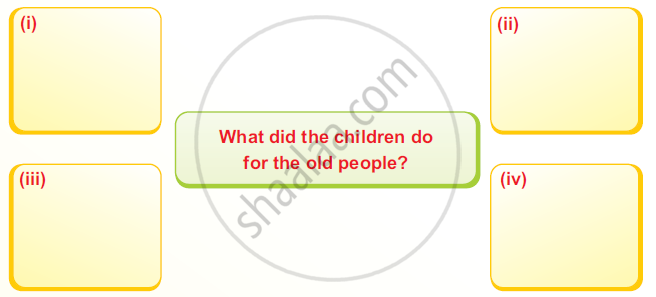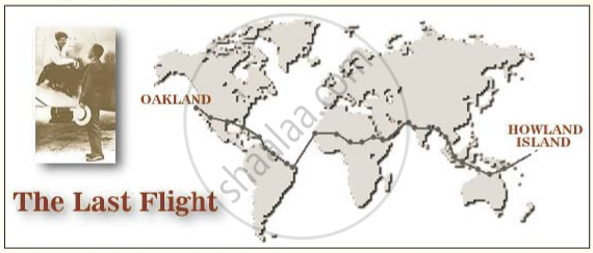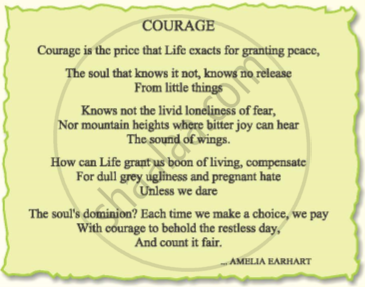Advertisements
Advertisements
प्रश्न
Answer the question.
What do you think these phrases from the poem mean?Leave their greens.
उत्तर
Some of the children don’t eat their lunch in full. They leave cooked green vegetables here and there or throw them into the dustbin.
APPEARS IN
संबंधित प्रश्न
Answer of these question in a short paragraph (about 30 words).
Why did Margie’s mother send for the County Inspector?
Answer the following question in one or two sentences.
What was Kezia’s father’s routine
(i) before going to his office?
(ii) after coming back from his office?
(iii) on Sundays?
Thinking about the Poem
How did he punish her?
For whom does the prince send the sapphires and why?
Now rewrite the pair of sentences given below as one sentence.
He gave the little girl an apple. He took the computer apart.
The teacher will read out the story of a young girl about a special day.
One day our teacher announced that there was a surprise awaiting us the next day. We were asked to get whatever little pocket money we could.
The next day our teacher said, 'Today is Grandparents' Day' and you will be meeting many grandparents who do not live with their families. Yes, we were going to an Old Age Home! On the way we bought a nice big cake, chart paper and balloons. We entered an old, big building. Later we were taken into a hall and were allowed to decorate it.
We blew balloons and hung them around the hall. We cut out chart paper, wrote quotes, drew pictures and stuck them on the wall. Then came in all the grey–haired sweethearts, some alone, some couples, some in groups ans settled down.
It was time to welcome them. Robert, who was a good speaker, greeted them and told them that we had come along to make their day a little special. We gathered in front and started singing songs for them. Most of the people were single grandparents whose spouses had expired. The other few were couples; many of them were smiling and singing along too. But there were a few who sat without any expression. While some of us sang the others sat beside them and spoke to them.
Two of us cut the cake into several pieces to be distributed. We were informed by the caretaker that there were diabetic people amongst them and they couldn't have sweets. He said they could have fruit instead the non-diabetics and fruit to those who were diabetic. Many of them missed their grand children. One of them told me that her son was in the U.S. and as he found it difficult to look after her, he had left her at this Home.
While returning home we realized that our grandparents are lonely and insecure. They spend their second childhood in their old age homes. Most of those living in old age homes do not complain. It is left to us to decide how happy their old age can be. We do not need any special day to make them feel their worth. If you have never told them how much you love them, say it before it's too late.
(b) List any three feelings of the old people in this story.
- _____________________________
- _____________________________
- _____________________________
(c) Complete the following :
- We can make our grandparents happy by ________________
- We can avoid constructing more and more Old Age Homes by___________
The world's most famous female aviator, Amelia Earhart, disappeared in 1937, as she attempted to become the first woman to fly around the world with her navigator, Fred Noonan. She was last heard when she was around 100 miles from the tiny Pacific Howland Island on July 2, 1937.
Read the story of her 'Final Flight'.
On June 1, 1937 Amelia and her navigator Fred Noonan departed from Miami, Florida; bound for California. Their first destination was San Juan, Puerto Rico; from there, skirting the northeast edge of South America; and then on to Africa and the Red Sea.
The flight to Karachi was another first. No one had previously flown non-stop from the Red Sea to India before. From Karachi, the Electra flew to Calcutta on June 17 from there on, to Rangoon, Bangkok, Singapore and Bandoeng.
The monsoon prevented departure from Bandoeng for several days. Repairs were made on some of the 'long distance' instruments which had given trouble previously. During this time, Amelia became ill, and suffered from dysentery that lasted several days.
It was June 27 before Amelia and Noonan were able to leave Bandoeng for Port Darwin, Australia. At Darwin, the direction finder was repaired, and the parachutes were packed and shipped home as they would be of no value over the Pacific .
Amelia reached Lae in New Guinea on June 29. At this point they had flown 22,000 miles and there were 7,000 more to go over the Pacific. Amelia cabled her last commissioned article to the Herald Tribune. Photos show her looking very tired and ill during her time at Lac.
The U.S. Coast Guard cutter, Itasca had been standing off Howland Island for some day to act as a radio contact for Amelia Radio communications in the area were very poor as Itasca was overwhelmed with commercial radio traffic that the flight had generated .

Amelie left Lae at preciaely 00:00 hours Greenwich Mean Time on July 2 . It is believed that the Electra was loaded with 1,000 gallons of fuel , allowing for 20-21 hours of flying .
At 07:20 hours GMT Amelia provided a position report placing the Electra on course as some 20 miles southwest of the Nukumanu Islands . The last weather report Amelia was known to have received was before take-off . The head wind speed had increased by 10-12 mph, but it is not known if she ever received the report.
At 08:00 GMT Amelia made her last radio contact with Lae . she reported being on course for Howland Island at 12,000 feet . There is no real evidence as to the precise track of the aircraft after Nukumanu . No one saw or heard the plane fly over .
Several short transmissions were received by the Itasca with varying signal strengths but they were unable to get a fix on her location because they were too brief. At 19:30 GMT the following transmission was received from the Electra at maximum strength.
"KHAQQ calling Itasca. We must be on you but cannot see you ... gas is running low ... "
At 20: 14 GMT, the Itasca received the last voice transmission from Amelia giving positioning data. The Itasca continued to transmit on all frequencies until 21:30 hours GMT. They determined that Amelia must have died at sea and began to implement search procedures.
It has been determined that the plane went down some 35-100 miles off the coast of Howland Island. A life raft was stowed on board but no trace was ever found of the raft. Some experts felt that the empty fuel tanks could keep the plane afloat for a period of time.
President Roosevelt authorized a search party of 9 naval ships and 66 aircrafts at an estimated cost of over $4 million. On July 18, the search was abandoned by ships in the Howland area. George continued to seek help in the search, but by October he too abandoned all hope of finding them alive.
Amelia had been sending letters to George at stopovers all along her route quite regularly. These were published in the book 'Last Flight'. The book has a note from her to George ....
"Please know I am quite aware of the hazards ... I want to do it because I want to do it. Women must try to do things as men have tried. If they fail, their failure must be, but a challenge to others. "

Amelia created a number of aviation records :
o The first woman to fly across the Atlantic in 1928
o The second person to fly solo across the Atlantic in 1932
o The first person to fly solo from Hawaii to California in 1935 Guided by her publicist and husband, George Putnam, she made headlines in an era when aviation had gripped the public's imagination.
Understanding the tenses:
The tense forms that have been practised and discussed in this chapter, allow
you to show accurately and subtly the time and the relationship of actions and
events with it. We use them in speech and writing.
Understanding and recognising how the tense forms are used.
Can you identity the present tense forms.
Simple Present Present Perfect
1. I llli!¥ tennis 1. I have played tennis
2. You read well. 2. You have read well.
3. She sees something 3. She has seen something.
Present Continuous
1. I am playing tennis
2. You are reading well
3. She is looking at something.
Simple Past Past Perfect
1. I knew about it 1. I had known about it
2. You took it away 2. You had taken it away
3. She finished her work. 3. She had finished her work.
Present Continuous Past Continuous
1. I am reading a book. I was reading a book.
2. They are playing football outside. They were playing football outside.
3. She is looking for her friend. Last week, she was looking for her friend.
Notice how ideas are connected in the story.
Write what the following words you just used in 1.1 imply by choosing suitable options from the box.
- and:
- but:
- where:
- while:
- after:
- until:
- so :
connects similar actions, objects
denotes contrast
denotes time.
The words given above are called connectors. Connectors do not simply join sentences together; they also show how ideas are related.
There are many different ways of classifying connectors according to their meaning. We shall start with the ones you are already familiar with.
What does he plant who plants a tree? a
He plants a friend of sun and sky;b
He plants the flag of breezes free;
The shaft of beauty, towering high;
He plants a home to heaven anigh;
For song and mother-croon of bird
In hushed and happy twilight heard____
The treble of heaven's harmony_____
These things he plants who plants a tree.
Read the lines given above and answer the question that follow:
The blocks were all lined up for those who would use them
The hundred-yard dash and the race to be run
These were nine resolved athletes in back of the starting line
Poised for the sound of the gun.
The signal was given, the pistol exploded
And so did the runners all charging ahead
But the smallest among them,he stumbled and staggered
And fell to the asphalt instead.
He gave out a cry in frustration and anguish
His dreams ands his efforts all dashed in the dirt
But as sure I'm standing here telling this story
The same goes for what next occurred.
Read the lines given above and answer the following question:
How many competitors were there for the events?
When there was a strong wind, the pine trees made sad, eerie sounds that kept most people to the main road. But Mr. Oliver was not a nervous or imaginative man. He carried a torch – and on the night I write of, its pale gleam, the batteries were running down – moved fitfully over the narrow forest path. When its flickering light fell on the figure of a boy, who was sitting alone on a rock, Mr. Oliver stopped.
Boys were not supposed to be out of school after seven P.M. and it was now well past nine. What are you doing out here, boy, asked Mr. Oliver sharply, moving closer so that he could recognize the miscreant.
Read the extract given below and answer the question that follow.
What was Mr Oliver’s reaction?
Joe did not see the Guardians of the Poor on that day, on the next, nor on the day following. In fact, he never saw them at all on Maggie’s account, for in less than a week Mrs. Joe Thompson would as soon leave thought of taking up her own abode in the almshouse as sending Maggie there.
What light and blessing did that sick and helpless child bring to the home of Joe Thompson, the poor wheelwright! It had been dark, and cold, and miserable there for a long time just because his wife had nothing to love and care for out of herself, and so became soar, irritable, ill-tempered, and self-afflicting in the desolation of her woman’s nature. Now the sweetness of that sick child, looking ever to her in love, patience, and gratitude, was as honey to her soul, and she carried her in her heart as well as in her arms, a precious burden. As for Joe Thompson, there was not a man in all the neighbourhood who drank daily of a more precious wine of life than he. An angel had come into his house, disguised as a sick, helpless, and miserable child, and filled all its dreary chambers with the sunshine of love.
Read the extract given below and answer the question that follow.
What changed her ? Describe the change in her.
Had the beggar come to Rukku Manni’s house for the first time? Give reasons for your answer.
Why the king changed his clothes and left behind his bodyguards and horse before meeting the hermit?
What did the farmer’s wife regret?
What are the games or human activities which use trees, or in which trees also ‘participate’?
Complete the following sentence.
The banyan tree served the boy as a ________.
Read the extract given below and answer the questions that follow:
| Portia: The quality of mercy is not strained; It droppeth as the gentle rain from heaven Upon the place beneath : it is twice blessed : It blesseth him that gives and him that takes. Tis mightiest in the mightiest; it becomes The throned monarch better than his crown: |
- Where does this scene take place? Why Is Portia here? [2]
- To what is mercy compared in these lines? [2]
- Why does Portia call mercy ‘twice blessed’?
Explain the lines:
‘Tis mightiest in the mightiest: it becomes
the throned monarch better than his crown: [3] - Later in her speech Portia mentions a sceptre. What is a sceptre?
How, according to Portia, is mercy above the ‘sceptred sway’? [3]
With close reference to Act V, examine how Shakespeare presents the idea of forgiveness and reconciliation at the end of the play.
